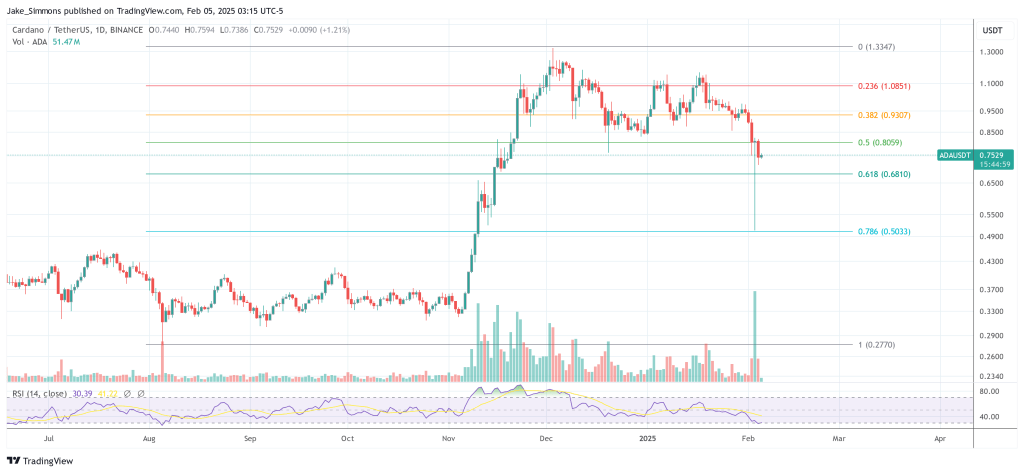In a livestream on February 4, 2025, Charles Hoskinson, founding father of Cardano and CEO of Enter Output World (IOG), delivered a stark rebuke of Wyoming’s plan to expand a state-backed stablecoin. Hoskinson alleges that “freeze and grab” necessities—enabled via cryptographic gear to stop or opposite transactions—had been by no means overtly disclosed in a correct product necessities file (PRD), successfully except for Cardano and different main blockchain platforms from rivalry.
Cardano Founder Slams Wyoming’s Stablecoin As CBDC
Hoskinson’s remarks focal point at the absence of transparency in Wyoming’s procurement procedure. In line with him, the state didn’t submit or proportion an in depth PRD that outlines key must-have options, akin to the power to freeze or grab tokens beneath positive felony or regulatory prerequisites. He says that this omission no longer simplest prevents truthful pageant but in addition poses dangers to consumer privateness and broader blockchain adoption.
“We had been informed it might be an open procedure and we might know forward of time what the product necessities can be,” Hoskinson says within the video. “As an alternative, they concealed the PRD… and made up our minds to qualify other people themselves.”
He contends that Wyoming’s variety standards had been simplest disclosed after the truth, at which level the state allegedly gave not up to 5 days for corporations to end up they may meet the freeze-and-seize requirement. The Cardano ecosystem, he argues, can have carried out one of these characteristic in roughly two weeks if it have been explicitly integrated within the PRD from the outset.
To focus on Cardano’s functions, Hoskinson contrasts totally programmable blockchains like Cardano and Ethereum with so-called “fixed-function” ledgers, together with XRP. Programmable chains permit builders to construct new options at once into good contracts, that means a freeze-and-seize capacity may also be added if required.
“On Cardano or Ethereum, if there’s one thing the protocol doesn’t reinforce natively, you write a sensible contract,” he explains. “So, if we had recognized freeze-and-seize was once a Hardline product requirement, we can have merely written a freelance to fulfill it.”
Hoskinson issues to what he calls a mischaracterization via officers overseeing Wyoming’s stablecoin mission, who had mentioned that Cardano didn’t meet this criterion with out clarifying the quick timeline or undisclosed necessities.
All the way through the video, Hoskinson means that the method can have been orchestrated to choose a selected blockchain resolution, suggesting that some of the decision-makers in the past labored with the platform being singled out for the mission. He underscores that no open bidding or public dialogue came about at the important options of the stablecoin.
Hoskinson additionally evaluations the concept Wyoming’s stablecoin can be functionally very similar to a central financial institution virtual foreign money (CBDC) on account of its freeze-and-seize characteristic and clear ledger, caution that this undermines monetary privateness. In his view, this structure offers government—and even 3rd events—the facility to observe all transactions and freeze finances at will.
“In case you grasp Wyoming stablecoin, know that the whole thing you purchase is monitored and tracked,” Hoskinson says. “At any given time, civil asset forfeiture… they may be able to simply grab it.” He questions the common sense of making an investment state assets to construct a product that, in his estimation, competes head-on with extra established gamers—akin to Tether or Circle—that have a long way higher budgets and marketplace proportion.
In his remarks, Hoskinson underscores the commercial demanding situations Wyoming’s stablecoin may just face, mentioning a modest $5.8 million price range and a all of a sudden moving regulatory setting. He argues that established stablecoin issuers generate billions in earnings and will pivot temporarily to procure or adapt to new rules, leaving little room for a nascent state-backed mission to realize marketplace traction.
“Tether made $13 billion ultimate yr. Circle made mainly the similar,” he notes, mentioning the serious pageant. “You’ve gotten a $5.8 million price range… and on the finish of the day, you’re sitting on a CBDC in Wyoming.”
He additional questions why the state would no longer merely “white label” an present stablecoin infrastructure slightly than construct from scratch, noting that negotiating a proportion of Treasury invoice earnings or passion bills may just theoretically get advantages Wyoming with out incurring huge construction prices.
Hoskinson, who lives in Wheatland, Wyoming, frames his complaint as a protection of native citizens. He argues that public finances are being jeopardized in a challenge that can fail to ship a significant get advantages to the state’s taxpayers. In his view, had the PRD been overtly to be had—in particular the freeze-and-seize requirement—Cardano, amongst different platforms, would have submitted a bid extra aligned with the state’s purported objectives.
“They don’t deserve that,” he says of Wyoming’s body of workers. “This isn’t how procurement works… no longer how any one will have to perform.” He calls on officers, together with state legislators, to scrutinize the mission extra carefully, emphasizing the will for tough debate about whether or not the stablecoin, as at this time structured, aligns with Wyoming’s pro-innovation symbol or inadvertently creates a centralized virtual foreign money beneath federal oversight.
At press time, Cardano traded at $0.75.

Featured symbol from YouTube, chart from TradingView.com
